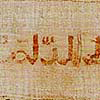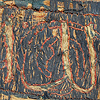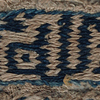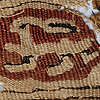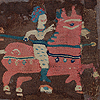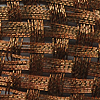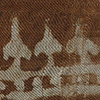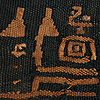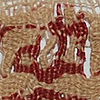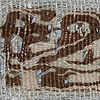 |
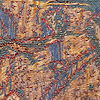
3042
Antique Early Islamic Textile with Silver Foil Wrapped Around Silk with Islamic Inscription, Egypt,
Fatimid Period
969 - 1171 A.D.
Size 9" x 2"
Size 23 x 5cm
Top and Below are Detail Images
Provenance: Formerly in the H. Kevorkian Collection
Cf: Tissus D’Egypte, Bouvier Collection Geneva
Analysis prepared by Dr.Julia Galliker, PhD, 10/30/2015
|
 An Important Early Islamic textile with Inscription
An Important Early Islamic textile with Inscription

Analysis prepared by Dr.Julia Galliker, PhD, 10/30/2015 Fragment Tiraz embroidered fragments 3042 and 3043 sewn to cardboard
Fragment
Dimensions (based
on measurement of
intact woven areas
only – max dims)
3042
Total height: 3.8 cm
Total width: 23.2 cm
3043
Total height: 4.3 cm
Total width: 27.1 cm
Photo: 1 fragments dim
Construction Comprises two textile layers with various types of embroidery applied to
the surface
Photo: 2 fabric layers 15 x mag
Base yellow gold
layer
Yellow-gold tabby weave silk (?), stained in areas
- Average density is 24 warps/wefts per cm
- both warp and weft are Z twist singles
- base fabric is uneven with large variation in weft and warp spacing.
- Yarn diameter is similarly uneven with wide measurement variation.
An average yarn diameter measurement for the warp and weft is
about 200 um.
Photo: 3 yellow silk x 150
Top blue layer Blue extended tabby weave silk with warps(?) grouped in pairs. Blue silk
layer is very brittle and breaks easily in exposed areas.
- Average density is 28 warp(?) pairs/28 weft(?) bundles per cm
- Yarns are tightly packed with no spaces visible between the yarns in
both the warp and weft.
- Warp(?) yarn comprises paired Z twist singles, approx. 110 um in
diameter.
- Weft(?) yarn comprises a thick bundle of untwisted fibers, approx.
250 um in diameter.
Photo: 4 blue top layer silk x 150 mag
Embroidery
characteristics
Complex embroidery on blue silk surface with four different components.
While the exact sequence of steps is difficult to discern because of the
degraded nature of the material, the following is a preliminary summary of
the embroidery sequence:
1 Red embroidery yarn - S ply 2 untwisted singles. This yarn was
applied to the blue surface in an outline stitch to form the lettering
design for the piece.
2 Dark gold untwisted single yarn bundle was applied in a horizontal
(in terms of the design) filling stitch to form the base embroidery
layer in the areas demarcated by the red outline stitch.
3 Silver (?) wire was applied over the gold embroidery/blue silk base
to fill in the design. The wire remained on the surface of the cloth
and did not go through to the reverse side. The wire was applied by
looping the metal through the red outline stitch.
Photo: 5 red yarn with wire 150 x mag
Photo: 6 yellow embroidery yarn 150 x mag
4 A red couching stitch was applied to hold the wire in place and to
cover the red outline stitch to make the design stand out.
Photo: 7 red couching stitch 50 x mag
5 A lighter yellow gold untwisted single yarn bundle was applied over
the wire to emphasize portions of the lettering design. The stitch was
an outline stitched used for filling.
Photo: 8 top embroidery layer 15 x mag
Photo: 9 top layer of pale gold embroidery 5 x mag
Possible uses This tiraz design was apparently applied to a larger object such as a robe or
other garment. Since there are no finished edges, the surviving bands were
cut away from the base object.
Impression The piece is an example of complex tiraz embroidery finely worked on the
surface of layered silk fabric. The wire embroidery is relatively intact and
represents a good example of this form of embellishment. The fragment was
probably cut from a garment found in a burial context. Overall the
fragments are in fragile condition with significant loss on piece 3042.
 .
. |
 |
